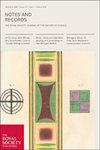“太多了,我无法谈论”:约翰·瓦利斯生活和遗产的许多方面
IF 0.6
3区 哲学
Q3 HISTORY & PHILOSOPHY OF SCIENCE
Notes and Records-The Royal Society Journal of the History of Science
Pub Date : 2018-10-10
DOI:10.1098/RSNR.2018.0047
引用次数: 0
摘要
许多早期现代男性和女性留下了文件和手工艺品,这些文件和手工制品表明了他们希望如何被人们记住。1703年,牛津数学家和神学家约翰·瓦利斯去世时,他已经为后代留下了几件这样的物品。例如,1697年,他给朋友、抹大拉学院的托马斯·史密斯写了一封自传体信。这封信的开头讲述了1616年出生于肯特郡阿什福德的瓦利斯是如何在1632年被剑桥埃马纽埃尔学院录取之前,在肯特郡和埃塞克斯郡的学校度过童年的。从埃马纽埃尔大学毕业后(1637年)和文学硕士(1640年),瓦利斯被任命为牧师,如果不是因为信中描述的某些意外的发展,他可能会继续走牧师的职业道路,这使他走向了一个不同的职业。特别是,沃利斯解释了他是如何在1631年圣诞节从剑桥回家时发现自己的数学天赋的,当时他从正在接受窗帘师职业培训的哥哥那里学习了基本算术。1649年,沃利斯被任命为Savilian几何教授,尽管他几乎没有受过数学训练,但他的天生数学能力将被证明是无价的。尽管他被任命的原因至少部分是政治原因,1但结果是惊人的:沃利斯在1650年代出版了一系列开创性的数学著作,在接下来的半个世纪里,他继续享受着漫长而富有成效的数学生涯。沃利斯自传体信件的其余部分集中于他一生中参与的重大事件,从在威斯敏斯特神学院担任抄写员到他是伦敦皇家学会的积极成员…本文章由计算机程序翻译,如有差异,请以英文原文为准。
‘Too much for mee to speake of’: the many facets of John Wallis's life and legacy
Many early modern men and women left behind documents and artefacts that suggested how they wanted to be remembered. By the time John Wallis, the Oxford-based mathematician and theologian, had died in 1703, he had left several such items for future generations. For instance, in 1697, he wrote an autobiographical letter to his friend Thomas Smith, fellow of Magdalen College. The letter begins with an account of how Wallis, born in Ashford, Kent, in 1616 to a minister and his wife, spent his childhood at schools in Kent and Essex before he matriculated at Emmanuel College, Cambridge, in 1632. After graduating BA (1637) and MA (1640) from Emmanuel, Wallis was ordained as a minister and might have stayed on the clerical career path if not for certain unexpected developments, described in his letter, that led him toward a different career. In particular, Wallis explained how he discovered his aptitude for mathematics when, while home from Cambridge for Christmas in 1631, he learned basic arithmetic from his brother, who was training for a career as a draper. Wallis's natural mathematical ability would prove invaluable when, in 1649, he was installed as Savilian Professor of Geometry despite having little mathematical training. Although the reasons for his appointment were at least partly political,1 the results were spectacular: Wallis published a flurry of ground-breaking mathematical works during the 1650s, and he went on to enjoy a long and productive mathematical career for the next half-century. The rest of Wallis's autobiographical letter focuses on the significant events in which he participated throughout his life, from serving as a scribe in the Westminster Assembly of Divines to the founding of the Royal Society of London, of which he was an active member.2 These were the aspects of his career that Wallis sought to preserve …
求助全文
通过发布文献求助,成功后即可免费获取论文全文。
去求助
来源期刊
CiteScore
1.50
自引率
0.00%
发文量
45
审稿时长
>12 weeks
期刊介绍:
Notes and Records is an international journal which publishes original research in the history of science, technology and medicine.
In addition to publishing peer-reviewed research articles in all areas of the history of science, technology and medicine, Notes and Records welcomes other forms of contribution including: research notes elucidating recent archival discoveries (in the collections of the Royal Society and elsewhere); news of research projects and online and other resources of interest to historians; essay reviews, on material relating primarily to the history of the Royal Society; and recollections or autobiographical accounts written by Fellows and others recording important moments in science from the recent past.

 求助内容:
求助内容: 应助结果提醒方式:
应助结果提醒方式:


